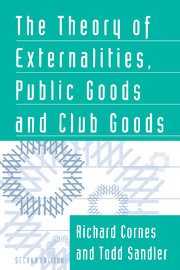Book contents
- Frontmatter
- Contents
- List of tables and figures
- Preface
- Part I Introduction to the theory of externalities, public goods, and club goods
- Part II Externalities
- Part III Public goods
- 6 Pure public goods: Nash-Cournot equilibria and Pareto optimality
- 7 Alternative mechanisms for provision of public goods
- 8 Public goods in general
- 9 Game theory and public goods
- 10 Departures from Nash-Cournot behavior
- Part IV Clubs and club goods
- Part V Applications and future directions
- References
- Author index
- Subject index
6 - Pure public goods: Nash-Cournot equilibria and Pareto optimality
Published online by Cambridge University Press: 05 June 2012
- Frontmatter
- Contents
- List of tables and figures
- Preface
- Part I Introduction to the theory of externalities, public goods, and club goods
- Part II Externalities
- Part III Public goods
- 6 Pure public goods: Nash-Cournot equilibria and Pareto optimality
- 7 Alternative mechanisms for provision of public goods
- 8 Public goods in general
- 9 Game theory and public goods
- 10 Departures from Nash-Cournot behavior
- Part IV Clubs and club goods
- Part V Applications and future directions
- References
- Author index
- Subject index
Summary
The purpose of this chapter is to present and analyze a model of the simplest and perhaps best-known special case of an externality, that of the single pure public good. Developed long before Samuelson (1954, 1955) brought it to the attention of a wider audience in the mid-1950s, it remains a natural and useful starting point for the elaboration of more general and more complex models of public goods. Our exposition begins with a simple but versatile graphic representation and concentrates on two important features. First, we characterize and explore the comparative static properties of a simple and widely used concept of equilibrium, variously described in the literature as Nash-Cournot, Nash, noncooperative, zero-conjecture, or subscription equilibrium. Then we compare such equilibria, hereafter called Nash-Cournot, with the set of Pareto-efficient allocations. The comparison, which the diagram depicts very simply, reveals the tendency for equilibrium to result in the provision of an amount of the public good that falls short of its Pareto-efficient level.
Having introduced the basic model, we then extend the analysis in several ways. In view of the general presumption that market provision will underprovide public goods, Section 6.6 considers the problem of financing their provision through taxation. The emphasis is on the way in which the need to use distortionary taxes affects the condition for optimal public good provision that is associated with Samuelson.
- Type
- Chapter
- Information
- The Theory of Externalities, Public Goods, and Club Goods , pp. 143 - 197Publisher: Cambridge University PressPrint publication year: 1996



